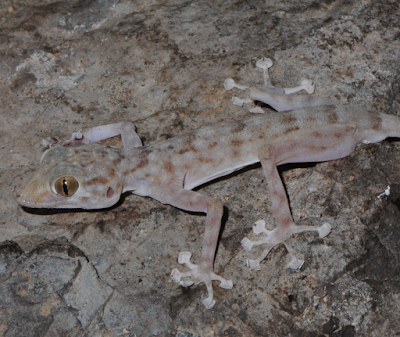 |
| Ptyodactylus ruusaljibalicus
Simó-Riudalbas, Metallinou, de Pous, Els, Jayasinghe, Péntek-Zakar, Wilms, Al-Saadi & Carranza, 2017
|
Abstract
The Hajar Mountains of south-eastern Arabia form an isolated massif surrounded by the sea to the east and by a large desert to the west. As a result of their old geological origin, geographical isolation, complex topography and local climate, these mountains provide an important refuge for endemic and relict species of plants and animals. With 19 species restricted to the Hajar Mountains, reptiles are the vertebrate group with the highest level of endemicity, becoming an excellent model for understanding the patterns and processes that generate and shape diversity in this arid mountain range. The geckos of the Ptyodactylus hasselquistii species complex are the largest geckos in Arabia and are found widely distributed across the Arabian Mountains, constituting a very important component of the reptile mountain fauna. Preliminary analyses suggested that their diversity in the Hajar Mountains may be higher than expected and that their systematics should be revised. In order to tackle these questions, we inferred a nearly complete calibrated phylogeny of the genus Ptyodactylus to identify the origin of the Hajar Mountains lineages using information from two mitochondrial and four nuclear genes. Genetic variability within the Hajar Mountains was further investigated using 68 specimens of Ptyodactylus from 46 localities distributed across the entire mountain range and sequenced for the same genes as above. The molecular phylogenies and morphological analyses as well as niche comparisons indicate the presence of two very old sister cryptic species living in allopatry: one restricted to the extreme northern Hajar Mountains and described as a new species herein; the other distributed across the rest of the Hajar Mountains that can be confidently assigned to the species P. orlovi. Similar to recent findings in the geckos of the genus Asaccus, the results of the present study uncover more hidden diversity in the northern Hajar Mountains and stress once again the importance of this unique mountain range as a hot spot of biodiversity and a priority focal point for reptile conservation in Arabia.
 |
| Fig 1. Geographical distribution and phylogenetic relationships of the two species from the Hajar Mountains. |
Taxonomy
Despite the high level of crypsis between the populations from the Ruus al Jibal and P. orlovi in the characters studied here, the results of the two mitochondrial and four nuclear gene fragments analysed (Figs 1B, 1C and 2) clearly show that these two lineages have been evolving independently for a long time. As a result of that, and based also on a few morphological traits (see diagnosis below, Tables 1 and 2 and S3 Table), we describe this unnamed population from the extreme northern part of the Hajar Mountain range as a new species.
Family Phyllodactylidae
Genus Ptyodactylus Goldfuss, 1820
Ptyodactylus ruusaljibalicus sp. nov.
Etymology. The specific name “ruusaljibalicus” is an adjective that refers to Ruus al Jibal, that means “Heads of the Mountains”, where all the specimens that belong to this species have been found to date and from where the species is probably endemic.
Diagnosis. A large size species of the genus Ptyodactylus characterized by the following combination of characters: (1) large size with a maximum recorded SVL of 90.01 mm for males and 85.94 mm for females (only one female known); (2) head narrow with elongated snout; (3) 12–13 infralabials and 12–14 supralabials; (4) dorsum with 9–11 irregular longitudinal rows of round, enlarged and slightly keeled tubercles; (5) absence of enlarged tubercles on the dorsal side of the extremities; (6) four prominent cloacal tubercles at the tail base (two on each side); (7) 9–11 subdigital scales on the 4th finger and 10–11 under the 4th toe; (8) 18–22 terminal lamellae under the 4th finger and 20–22 under the 4th toe; (9) in life, uniform light grey dorsum, some specimens with dark brown transverse bands that extended onto the tail. Underside of body and tail ivory-white.
Distribution and ecology. Despite intensive sampling across the Hajar Mountain range and other areas in Arabia carried out between 2004 and 2014, Ptyodactylus ruusaljibalicus sp. nov. has only been found in the Ruus al Jibal region, from the Musandam Peninsula to the Dibba region in the UAE. It can be therefore considered endemic to this distinctive geographical area (Fig 1A). The northernmost and southernmost localities lie approximately 26 km northwest and 58 km south-west of the type locality, respectively. The minimum distance between Ptyodactylus ruusaljibalicus sp. nov. and P. orlovi is 23 km by air. Ptyodactylus ruusaljibalicus sp. nov. inhabits cliffs and cave fissures, rocks and boulders at different heights. The species is mainly nocturnal, although some specimens were out in the shade during the day.
Proposal of common names.
English: Ruus al Jibal fan-footed gecko
Arabic: الأقدام مروحية الجبال رؤوس وزغة
Marc Simó-Riudalbas, Margarita Metallinou, Philip de Pous, Johannes Els, Sithum Jayasinghe, Erika Péntek-Zakar, Thomas Wilms, Saleh Al-Saadi, Salvador Carranza. 2017. Cryptic Diversity in Ptyodactylus (Reptilia: Gekkonidae) from the northern Hajar Mountains of Oman and the United Arab Emirates uncovered by An Integrative Taxonomic Approach.
PLoS ONE. 12(8): e0180397. DOI: 10.1371/journal.pone.0180397
PLoS ONE. 12(8): e0180397. DOI: 10.1371/journal.pone.0180397





